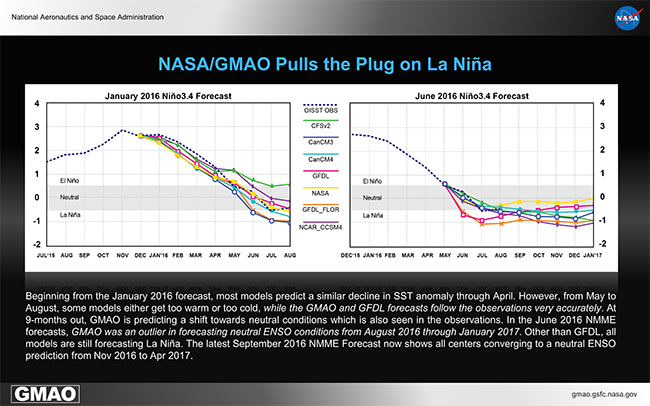NASA/GMAO Pulls the Plug on La Niña
The GMAO produces experimental near real-time coupled seasonal forecasts with the Goddard Earth Observing System (GEOS-5) Atmosphere-Ocean General Circulation Model (AOGCM). These forecasts are provided to the North American Multi-Model Ensemble (NMME) prediction project each month.
This multi-model approach helps to reduce the uncertainty involved in forecasting events nine to twelve months in advance. By providing the forecasts and analyses to the external community, we are able to assess the quality of the GEOS-5 forecast system in the context of other state-of-the-art systems, and we benefit from having various external users providing a more comprehensive evaluation our system.
The two figures show sea-surface-temperature (SST) anomaly forecasts from the NMME for the Niño3.4 region in the central Equatorial Pacific (5S-5N, 170W-120W). This Niño3.4 region is the primary focus for predicting El Niño. The left figure is the January 2016 forecast and the right figure is the June 2016 forecast. There are forecasts from seven modeling centers (CFSv2, CanCM3, CanCM4, GFDL, NASA, GFDL_FLOR, NCAR_CCSM4), with NASA (GMAO) shown in gold squares. The dashed blue curve shows the OISST observed SST (NOAA 1/4° Optimum Interpolated SST) at the time up to the forecast initial conditions, then extended to real-time. The grey shading between 0.5°C and -0.5°C depict the limits of El Niño or La Niña, respectively
In the January 2016 NMME forecast, you can see the peak of the 2015 El Niño that occurred in November in the blue observation curve. From this January forecast, all the models show a slow cooling of the SST anomaly to April 2016. After that, the GFDL and CFSv2 forecast deviate on the warm side, and CanCM3 and GFDL_FLOR deviate on the cool side. From April to August, the NASA curve follows the dashed blue OISST observations curve almost perfectly and both stay in the neutral range between 0.5°C and -0.5°C.
In the June 2016 NMME forecast, NASA is an outlier from August 2015 to January 2017 in predicting neutral SST anomalies, where the other models (except for GFDL) are predicting below the La Nina threshold.
Although it is not shown here, the latest NMME forecast for September 2016 shows all models in agreement for a neutral ENSO from November 2015 through April 2017.
NASA/GMAO Forecasts: https://gmao.gsfc.nasa.gov/cgi-bin/products/climateforecasts/GEOS5/index.cgi
NMME Forecasts: http://www.cpc.ncep.noaa.gov/products/NMME/
NASA Feature: http://www.nasa.gov/feature/goddard/2016/after-strong-el-nino-nasa-sees-return-to-normal


